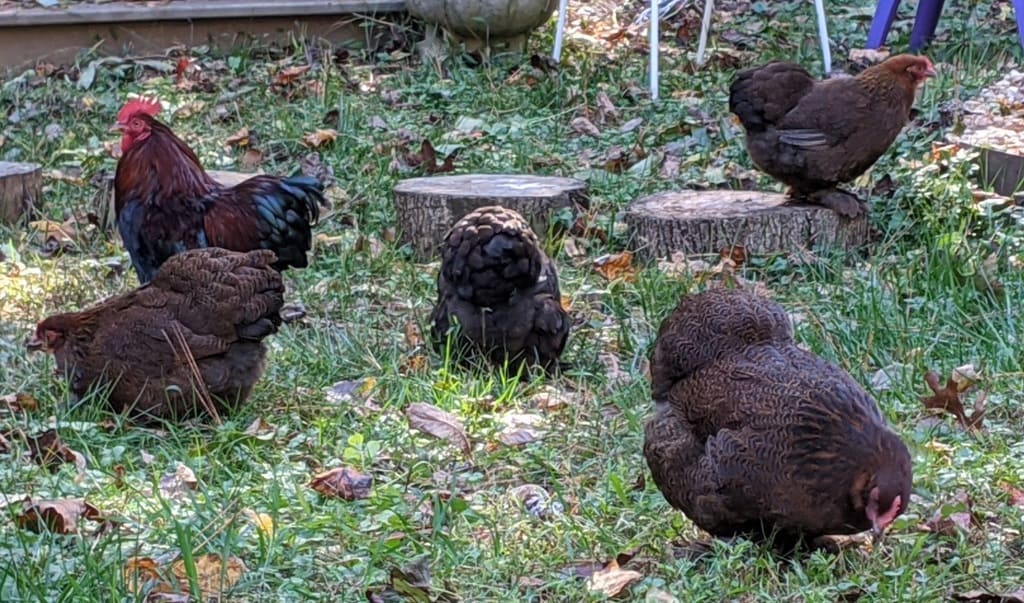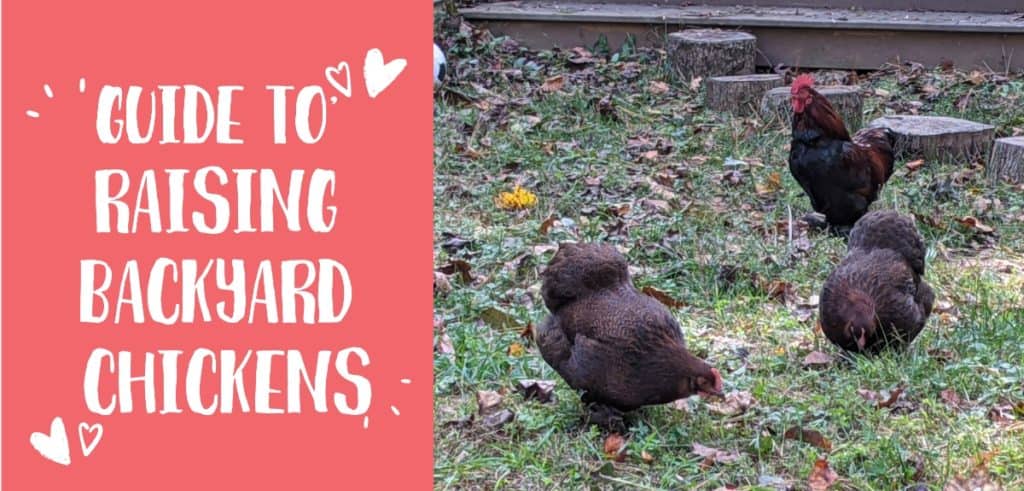
Raising backyard chickens can be a rewarding experience, but it’s important to know what you are getting into.
If you want to raise chickens for fresh eggs, or just give your kids the opportunity to learn about farm life raising chickens provides valuable life lessons.
This beginner’s guide to raising backyard chickens will help you understand how to raise chickens and prepare for your first batch of baby chicks.
It will cover everything from selecting the breed that best fits your needs and lifestyle. I will also go through setting-up an appropriate coop in order to ensure success at raising them from baby chicks until they reach maturity.
- Important Questions to Consider Before Raising a Flock of Chickens
- What breed of chickens should I get?
- Where Can I Buy Baby Chicks?
- How Many Chickens Should a Beginner Start With?
- Should I Buy Adult Hens, Pullets, Baby Chicks, or Hatching Eggs?
- What To Look For When Buying Chickens?
- What Do I Need to Raise Baby Chicks?
- What Type of Chicken Coop Do I need?
- Food and Water for your Chickens
- How Much Space Do Chickens Need?
- Do you Need a Rooster For Chickens to Lay Eggs?
- Conclusion
Important Questions to Consider Before Raising a Flock of Chickens
- Do I have adequate space for a chicken coop?
- Does my city allow me to keep chickens? (Check your local city ordinances)
- Am I prepared to feed them every single day and arrange care for them when I’m away?
- Will I clean their coop when it gets nasty and needs it?
- Why am I getting chickens? Is it for eggs, meat, or both? Is it for a hobby or eventual business?
- Am I prepared to purchase all the necessary supplies for chickens including, food, water and shelter needed.
What breed of chickens should I get?
If you are thinking of raising your own flock of chickens, then you must know that there are many chicken breeds available. Certain breeds will be easier to purchase depending on the area you live in. You should also take into consideration if you plan to free range your chickens.
This is important to consider because each breed has its own unique set of characteristics as well as advantages and disadvantages.
For this reason, it’s crucial for you to understand the various breeds before making your final decision about which one will work best in your particular situation.
There are many breeds of chickens that fall into these four categories.
Egg Laying Breeds
The best egg layers will lay up to 300 eggs per year. These include White Leghorns, Buff Orpingtons, Australorps, Golden comets, and others.
Dual Purpose Breed
These breeds are considered the best of both worlds. They lay a lot of eggs. Once the hens stop producing as many eggs as they age they are a still a good size for meat consumption.
Meat Breeds
These chickens are bred for their meat. Commonly known as broiler chickens some of the best meat breeds include the Cornish Cross and Jersey Giant. They are ready to be consumed between seven and nine weeks of age.
Heritage Breeds
Heritage breeds have a long productive outdoor lifespan as defined by the American Poultry Association. Cochins are one such breed with feathers on their feet.
My current chickens are a flock of Bantam Cochins. They are a smaller version of the standard Cochin.
That means they don’t have as much meat and lay smaller eggs. Just think two of their eggs equals one regular-sized egg.
I raise chickens as a hobby. We eat the eggs and my daughter enjoys playing with our flock. We have a small back yard, so I chose this ornamental breed due to its size, beauty, and sweet demeanor.
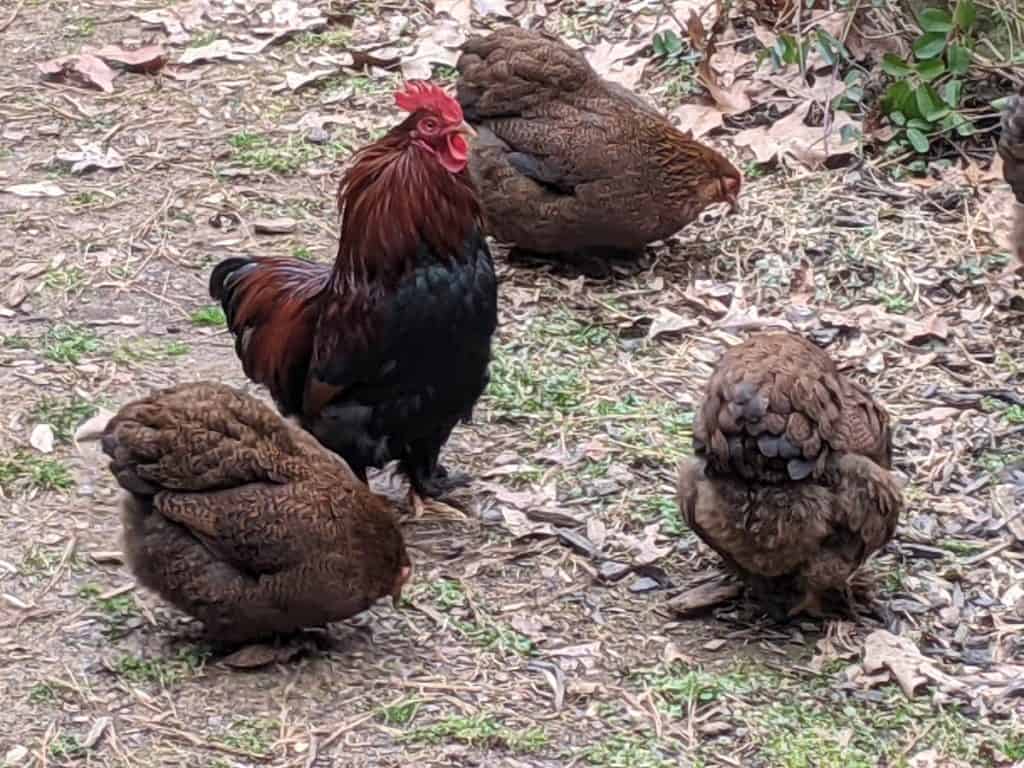
Where Can I Buy Baby Chicks?
You need to consider what type of baby chicks are available in your area. Many times you can purchase baby chickens from a store like tractor supply, a local farm, a hatchery or your local feed & seed store.
Check my article on where to buy baby chickens. If you want to check out some hatcheries to purchase chicks from.
How Many Chickens Should a Beginner Start With?
Many people want to start with chickens because they are extremely easy to care for, and they provide a lot of eggs. Some people think that having a few chickens will be enough, while others feel it’s best to get several birds.
The number you should have depends on your needs and expectations as well as the amount of space you have available.
If this is your first time raising backyard hens, then careful planning is required before taking the next step in purchasing them.
When thinking about how many chickens you need, consider the size of your family and how often you eat eggs. Also, consider factors such as space and budget.
You should start with no less than two egg-laying hens. This is the bare minimum. Chickens are social creatures and need companionship.
If you are purchasing baby chickens 6-10 is a good amount. Remember you may lose some chicks due to illness or predators once they are older.

Should I Buy Adult Hens, Pullets, Baby Chicks, or Hatching Eggs?
This will depend on how much money you want to spend and how much time you have. Adult hens are going to cost the most as they are at their egg-laying stage.
Pullets would be the next most expensive due to the time, care, and feed spent on them. Hatching eggs require an incubator, if you are inexperienced you should avoid this.
The cheapest option is usually baby chicks.
I recommend this especially if you have children as they can watch the baby chicks grow up through their entire life cycle. Just remember to wash your hands after holding the chicks!
What To Look For When Buying Chickens?
If you are going to a local store to purchase some baby chicks or getting larger chickens from a farm remember the following.
Make sure the chicks you purchase are eating, drinking, moving around, and are alert.
A baby chick’s legs should be straight and not splayed. Also, don’t purchase a chick that lower and upper beak do not line up. This is what is known as a scissor beak. This deformity can make it very hard for the chick to drink or eat.
Other bad signs to watch out for:
- Blocked vent area
- Eye or nasal discharge
- Chicken that is not moving
- Chicken that is alone by itself
- Curled in a ball
- The chicken looks sleepy or lethargic
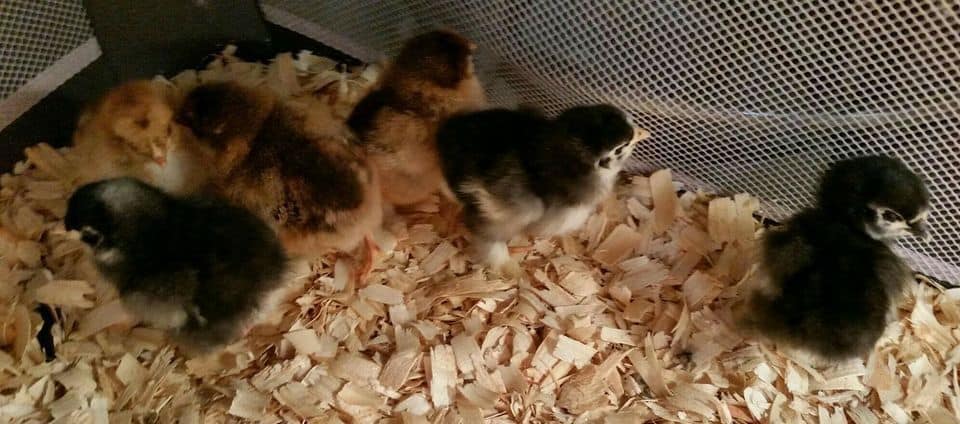
What Do I Need to Raise Baby Chicks?
Chicks are babies and they require a lot of care. Baby Chicks can not live on their own, they need to be taken care of and given a home with proper protection.
Time
Time is needed as your chicks will need someone to check on them several times throughout the day. They spill their food and water out a lot which can spread illness and diesease.
A brooder
A brooder also known as a brooding box is necessary in order to keep your chicks warm at nighttime. This is because they don’t produce enough heat on their own.
Anything with four walls and 18 inches (ca. 46 cm) high will work to start.
I like using the big blue plastic totes you buy at Home Depot. This works well when my chicks are small during their first 2-3 weeks of life. I have also used old kids playpen in the past.
Make sure if you have cats or dogs they can’t get to your chicks. I have 2 cats, and we had to keep our chicks in the basement so the cats couldn’t get to them.
A Heat Lamp For Warmth
A heat lamp is needed until your baby chicks are fully feathered. This can take anywhere from 4 to 6 weeks. Purchase one with a red light bulb.
The red bulb prevents baby chicks from pecking one another. It also makes it easier for them to sleep.
You can also try heating alternatives such as a chick brooder heat plate or similar type products.
For the first 2 weeks of the baby chick’s life the brooder temperature should be 95-100 degrees Fahrenheit (ca. 38 °C). This what temperature should be at the bottom where the baby chicks are.
You can adjust the heat they are receiving by moving the lamp closer or further back.
If you see the chicks far apart or panting you may have the heat lamp to close. If you see all the chicks huddled together the lamp may be to far away.
You will reduce the heat by 5 degrees each week until they have reached 6-7 weeks of age. At this time room temperature should be fine for the chicks.
Bedding Material
The bedding can be wood pine shavings, chopped straw corn cobs, or oat hulls. Like using the wood shavings which you can purchase at a local pet store. First put a towel or several layers of newspaper down then I add the wood shavings on top of that. This keeps the bottom from getting slippery due to their fecal matter.
When it is time to change out the bedding your can roll up the used material and throw it in your compost pile or put it in the trash.
Baby Chick Feeder with the Right Feed
Your baby chicks need to be feed chick starter feed crumbles. It has the right vitamins, minerals, and protein needed to start your chicks out on the right foot.
Starter chick feed contains about 20% protein content which is higher than the feed adult chickens get.
Chick Grit
You will also need to fed baby chicks grit if you are raising them indoors. You can start offering your chicks chick grit from the time they hatch until 8 weeks of age. Chick grit is much finer than normal grit.
Grit is small particles of rock that allow chickens to grind down food in their gizzard. When they are raised outside they naturally get small particles from the dirt.
However, you must provide these essential rock particles when raising them indoors
Baby Chick Feeder With Water
Your baby chicks need fresh water daily. They tend to poop in the water quite often. You may need to change in 3 or 4 times daily until they are older. Do not put water in a bowl.
They will knock it over and cause their bedding to become wet. This can cause health issues if they are in a wet place for an extended period of time.
I add a splash of apple cider vinegar to prevent pasty butt in our chicks. Pastybutt is a condition often found in young chicks.
The chick’s waste droppings stick to its vent area. This prevents the chick from excreting its feces. If you see this it must be treated immediately. You can clean the area with a warm wet washcloth and remove the feathers from the vent area.
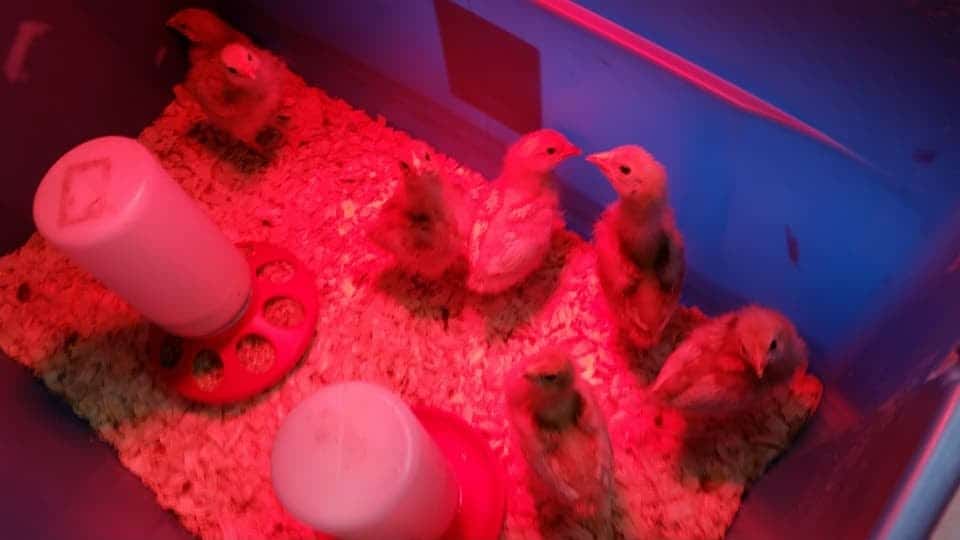
Introducing Your Chicks to The Outdoors
Once your chicks have reached 5 to 6 weeks of age you can introduce them to the outdoors under supervision. Do this for a couple of hours a day at a time.
They will need to be kept inside some type of enclosure or cage, so they won’t run off or get attacked. You can’t leave them unattended because they are easy prey for hawks or other airborne predators.
Once your chickens reach 10 to 12 weeks of age they are ready to be outside full time.
What Type of Chicken Coop Do I need?
You can purchase one online, build one yourself from online plans, or just use your imagination to build one if you’re handy. There are many types made of wood, plastic, or metal. Stationary coops and chicken tractors.
I built one that I used for many years seen in the picture below.
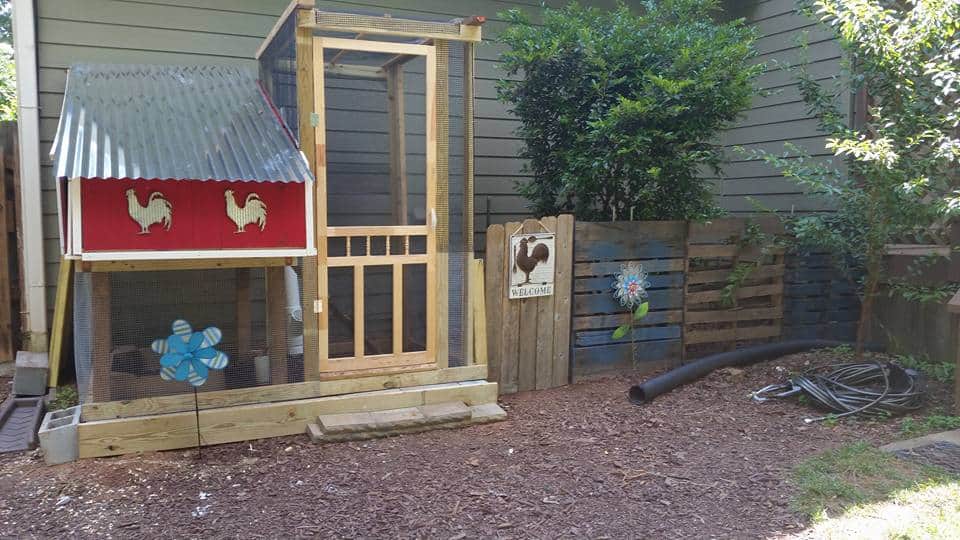
It served me well for several years until I purchased the Omlet Eglu this past year. The Omlet is a chicken tractor type that I absolutely love (picture below).

Your Coop Needs to Have the following:
Protection from predators
I have lost chickens to hawks, possums, and raccoons over the years. Your coop needs to keep predators out. There should be no spot where an animal can climb its way in, jump in or dig in.
Space for Movement
Your chickens need adequate space to move around. If they are too crowded pecking behavior and other issues could arise.
Protection from the Elements
Your coop needs to protect the flock from rain, wind, the sun, and snow. On a really hot day, there needs to be an area where they can get shade.
Ventilation
Your coop needs to keep your chickens cool in the summer and warm enough in the winter.
Nesting Boxes
Unless you want to search for the eggs your hens are laying you need a nesting box. The general rule is one nesting box for every three to four hens you have.
A Roosting area
Your flock needs a roosting area in the coop where they sleep at night. They will all sleep together in this area.
A Chicken Run
Your chickens need a run where they can move, scratch, and peck for bugs. An enclosed run is the safest option.
However, a run will tall fencing using chicken wire will keep out most predators during the day except hawks.
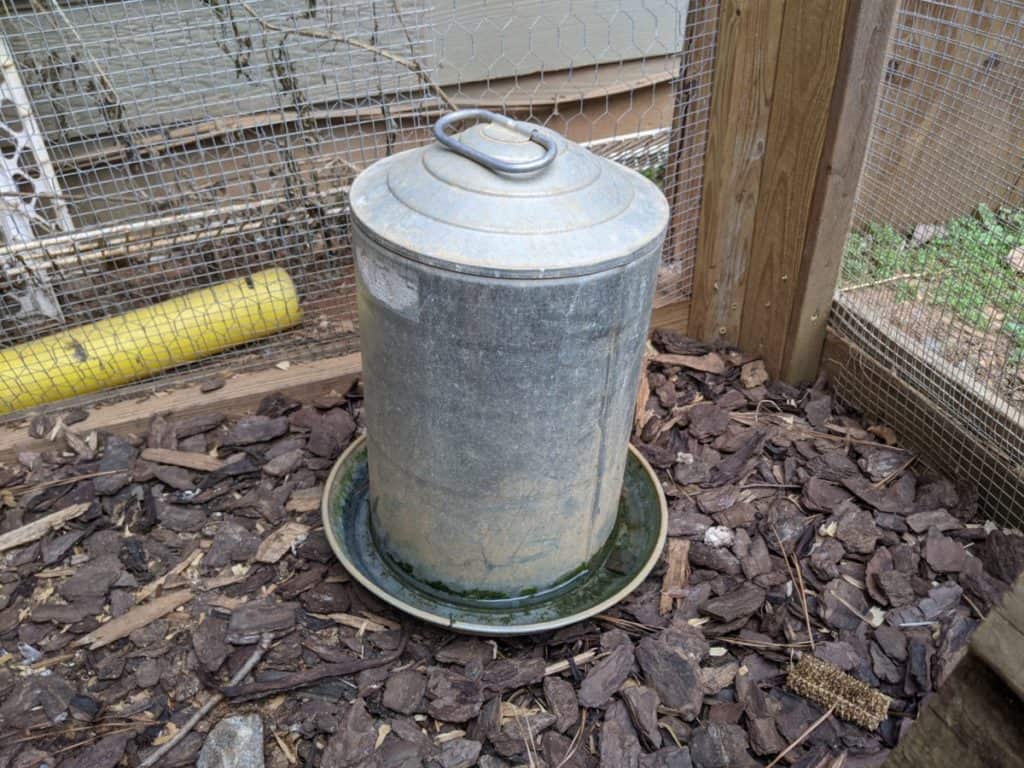
Food and Water for your Chickens
Once your chickens are outside they need food and water feeders. There are many types for both. I started with the Galvanized metal feeders. These work well for the most part.
You will want to put the water metal feeder on some bricks or something else that slightly raises it.
This will keep you from having to change the water constantly because of chicken feces getting in the water and trust it will often otherwise.
Feed your chickens at good layer feed with 18% protein content. This layer feed will give your chickens all the essential nutrients they need. You can purchase this from farm supply stores or online.
You should take the feeder in each night or store it in an enclosed space like a metal container. Chicken feed attracts rodents and other vermin you don’t want around.
Even if you’re free-ranging your chickens with lots of green space they still need a layer feed for proper nutrition and good egg production.

How Much Space Do Chickens Need?
Regular size chickens need 3 to 5 square feet (0.46 m²) of space per chicken in the coop area. This is assuming they also have access to a larger run area or an outdoor fenced-in area.
Do you Need a Rooster For Chickens to Lay Eggs?
Hens lay eggs whether there’s a rooster present or not. Hens will lay their first egg between 18 weeks or later. Backyard chickens that are well-fed with a proper layer feed should produce 250 eggs or more a year.
Roosters are really loud but they do protect the flock.
You need to know your local city ordinances if you are considering raising a rooster. Read my article on the pros and cons of having a rooster for more information.
Conclusion
Raising backyard chickens is a fun rewarding experience. Hopefully, this basic guide to raising backyard chickens will get you started on the journey to a rewarding hobby or new business.
Enjoy collecting those fresh eggs!
If you have other questions check out the other blog posts in my backyard chickens section. Here you will find answers to many other questions you may have.

